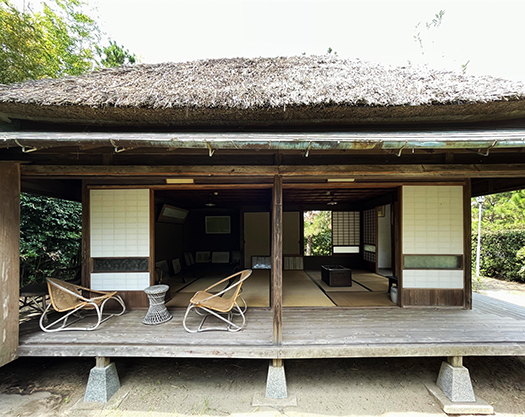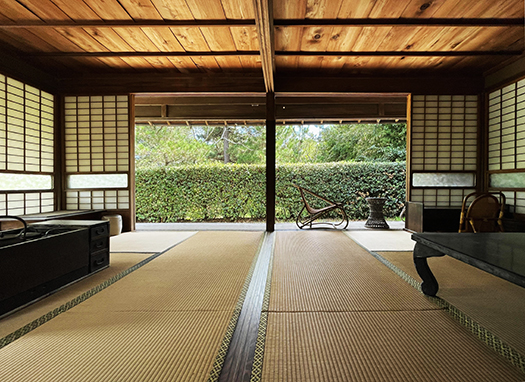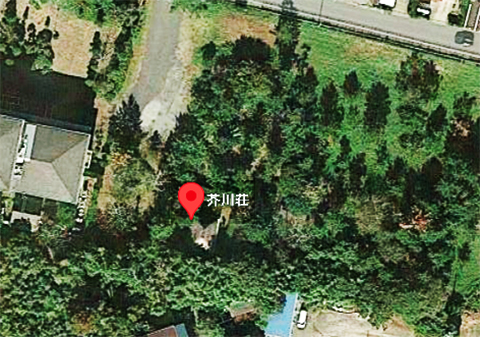

温暖地・蒸暑地での人間体感環境について、それはあまりにも日本民族にとって身近すぎてそれほど「科学する」対象ではなかったように感じる。一方で日本列島社会で、蝦夷地と呼ばれ続けた北海道はその過酷なまでの寒冷の冬が熱く「科学」されてきたと思います。
蝦夷地の利用とは明治以前には漁業資源収奪が日本民族にとって主要な興味対象であって、米作が不向きな気候条件から「一所懸命」の土地と見なされることはなかった。それが幕末ー明治の世界列強、とくに日本ではロシアの南下占領意図、むき出しの帝国主義侵略への対応としての日本民族の移民推進政策の結果、ようやく寒冷への居住環境ということを前向きに考え始めたといえる。
それまでの日本人にとって居住環境とはあるがままの「やさしい」自然条件のなかで、伝統的知恵にくるまれた安心感に満たされていたのだろうと思う。東北地域は別として。
北海道での「いごこちの科学研究」の進展によって、この居住環境研究はほぼ完成レベルにまで到達してきたと言えるのでしょう。今日北海道では、あえて「住宅性能」を謳い文句にするアピールはユーザーにダイレクトには「響かなく」なってきている。それは当然のことという認識が主流。
温暖地域で「エコハウスコンテスト」というカタカナ日本語で住宅性能イチ押しアピールが言われるけれど、北海道からはほとんど興味が寄せられないのが現実。
たまたま興味を持ったこの芥川龍之介の作家活動専念スタートの地でのボヘミアン・自由闊達な過ごしようの環境に触れることができて、寒冷地の人間としてその気候風土の「天国」ぶりに目を見張らされた。内地の人にとってはあまりにも自然そのものなのでしょうが、その「快適性」の引き立て要素としての住環境装置について、目を向けてみたくなった。
やはり茅葺き屋根による日射熱防御と軒の出による直射日光遮蔽、そして高床的な床下通風と北側以外の3方向の「全開放」による「自然通風」が最大の民族的知恵と言える。
茅葺きの熱環境効果についてはいろいろな研究が挙げられるけれど、確実な断熱・湿気蒸発効果が認められるのだと思う。長い民族史の中で建築の匠たちによる実証研究の結果、こうした到達点に至っていたのでしょう。
一方で自然通風による快適性効果は、たしかに温暖地にあってはその温湿度とも最高快適域に接近していて「うっとり」「ぼーっ」とさせられるレベル。
わたしも強い日射・高温環境の中,この芥川荘で家の中は天国に一番近いと認識させられた。むしろこういう「快適」をこそ「科学して欲しい」と思わされた。

そして民族の知恵はやはり環境全体にまで及んでいる。この芥川荘は九十九里の浜辺からは数百メートル離れているけれど、その緩衝地帯には防砂林のようにして緑地帯が設けられている。庵の南側にはしっかりと生け垣も造作されていて、室内側からも常に「目に優しい」緑が人間を護ってくれている。こういう「見た目」の快適感刺激要素をもっと科学分析して欲しいのだ。
こうした植物群の積層を通りわたってくる浜風は、その空気感がまた格別であるに違いない。ただでさえ心地よい通風感である以上に、微妙な草花たちの息づかい・におい、温度感・湿度感もそれに加わっているに違いないのだ。
English version⬇
The “Science” of Near Heavenly Comfort: Ryunosuke Akutagawa’s Hermitage in Kujukuri – 5
Experience the young Akutagawa’s free-spirited environment and background. I would like you to experience the science of this heavenly comfort along with high insulation and high airtightness. ・・・・・.
I feel that the human experience of the environment in warm and humid regions has not been the subject of much “science” because it is too familiar to the Japanese people. On the other hand, Hokkaido, which has been called “Ezochi” in Japanese archipelago society, has been hotly “scientifically” studied for its harsh, cold winters.
Before the Meiji era, the main interest of the Japanese people in the utilization of Ezo land was the exploitation of fishery resources, and it was never considered as a land where rice cultivation was “hard at work” due to its unsuitable climatic conditions. However, during the end of the Edo period and the Meiji period, the world powers, especially in Japan, began to think positively about the cold climate as a result of the Japanese people’s immigration policy as a response to Russia’s intention to occupy the southern part of the country and its aggression against the imperialist powers.
Until then, the Japanese people had been living in “gentle” natural conditions, wrapped in traditional wisdom, and filled with a sense of security. Except for the Tohoku region.
With the progress of the “science of comfort” research in Hokkaido, we can say that this residential environment research has almost reached the level of completion. Today in Hokkaido, appeals that dare to claim “housing performance” are no longer “resonating” directly with users. The mainstream perception is that it is a matter of course.
In warmer regions, “eco-house contests” are being held in katakana Japanese to promote housing performance, but the reality is that there is little interest in these contests from Hokkaido.
I happened to be interested in the bohemian and free-spirited environment of the place where Ryunosuke Akutagawa started his writing career, and as a person from a cold region, I was struck by the “heavenly” nature of the climate there. For those of us in the interior, it is probably too natural, but I wanted to take a look at the living environment equipment as a complement to the “comfort” of the environment.
After all, the greatest ethnic wisdom is the protection against solar heat by thatched roofs and the shielding of direct sunlight by eaves, as well as “natural ventilation” by ventilation under the floor like high floors and “full opening” in all three directions except the north side.
Various studies have been conducted on the thermal environmental effects of thatched roofs, but I believe that their heat insulation and moisture evaporation effects are recognized. It is likely that such a point of arrival was reached as a result of empirical research by architectural masters over a long period of ethnic history.
On the other hand, the comfort effect of natural ventilation is certainly at a level where the temperature and humidity are close to the maximum comfortable range in warm climates, making one feel “enchanted” and “light-headed”.
In the midst of strong sunlight and high temperatures, the Akutagawa Villa made me realize that the inside of my house is the closest thing to heaven. In fact, it is this kind of “comfort” that I wish would be “scientifically proven.
The wisdom of the people also extends to the environment as a whole. Although Akutagawa-so is located several hundred meters away from the Kujukuri beach, a greenbelt has been created in the buffer zone as if it were a sandbreak. A hedge has also been built on the south side of the hermitage, providing a “gentle to the eyes” green area for the protection of the residents from inside the house. I would like to see more scientific analysis of this kind of “visual” comfort stimulating factor.
The beach breeze coming through the layers of plants must have a very special airy feeling. In addition to the pleasant breeze, the subtle smells and breaths of the plants and flowers, the temperature and humidity must also add to the feeling of air quality.
Posted on 10月 10th, 2023 by 三木 奎吾
Filed under: 住宅マーケティング, 住宅性能・設備







コメントを投稿
「※誹謗中傷や、悪意のある書き込み、営利目的などのコメントを防ぐために、投稿された全てのコメントは一時的に保留されますのでご了承ください。」
You must be logged in to post a comment.